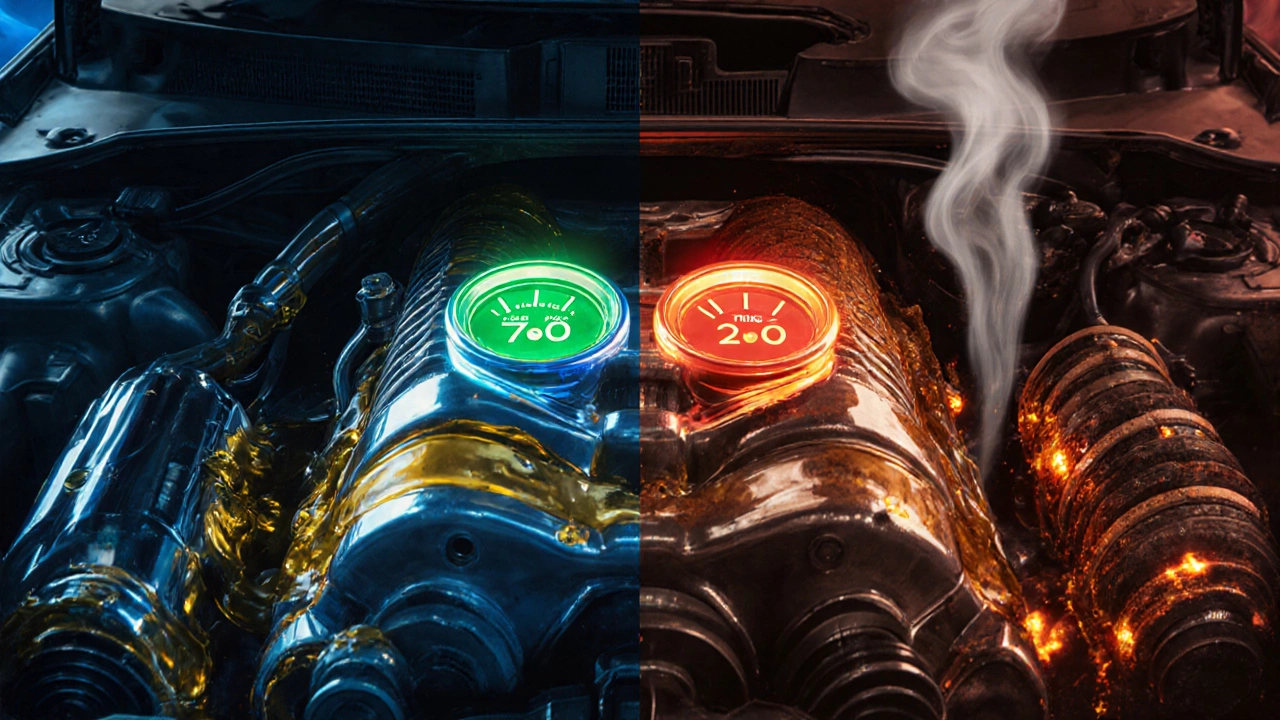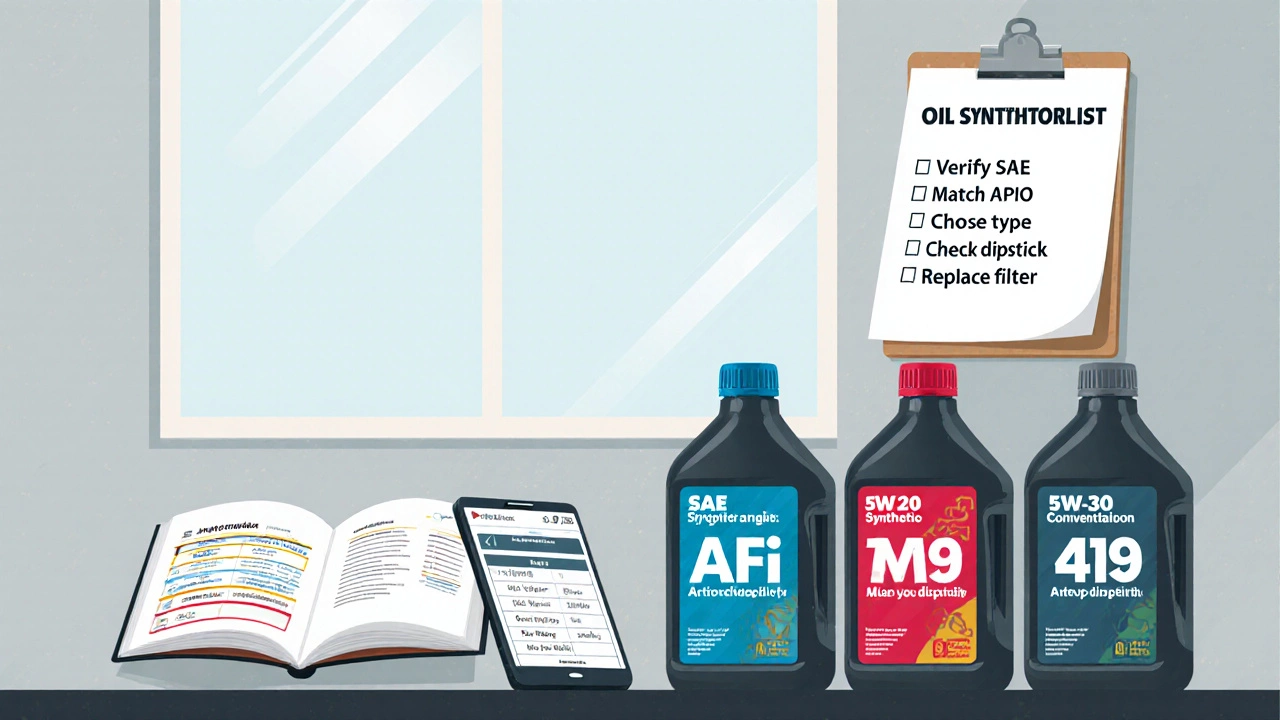Engine Oil Viscosity Calculator
Select Your Vehicle Parameters
Choose your vehicle details to get the correct oil viscosity recommendation
Pro Tip
Always consult your vehicle's owner's manual for the manufacturer's specific viscosity requirements. This calculator provides general recommendations based on common vehicle specifications.
Imagine pulling into a garage, handing the mechanic a bottle of oil, only to realise later you grabbed the wrong grade. Wrong oil can turn a simple service into a costly nightmare. This guide walks you through the science, the symptoms, and the exact steps to fix the mess if you ever make that mistake.
Understanding Oil Specifications
Before anything else, get clear on what Engine oil is a lubricant designed to reduce friction, carry heat away, and protect moving parts inside an internal combustion engine actually does. Two key specs matter:
- Viscosity grade is a measure of how thick or thin the oil is at certain temperatures, expressed as SAE numbers like 5W-30. The first number (5W) tells you how the oil behaves when it’s cold; the second (30) tells you how it performs at operating temperature.
- API service categories (e.g., SN, CJ‑4) indicate the chemical makeup and the engine types the oil is approved for.
Read the owner’s manual - it will list the exact SAE range (like 0W‑20 for a hybrid) and the required API rating. Skipping this step is the first pitfall.
Types of Oil and When They’re Used
Not all oil is created equal, and mixing the wrong type with the wrong engine can be disastrous.
- Synthetic oil is a high‑performance lubricant engineered at the molecular level for better flow at extreme temperatures. It’s the go‑to for modern turbocharged engines.
- Conventional oil is a refined petroleum product that works well in older, low‑stress engines.
- Blends combine synthetic and conventional bases for a middle‑ground price and performance.
- High‑mileage formulas add seal conditioners to help older engines with worn rings.
If you pour a conventional 10W‑40 into a 0W‑20‑required hybrid, you’re essentially feeding the engine a fuel it can’t burn efficiently.
What "Wrong Oil" Actually Means
There are three common ways you can end up with the wrong oil:
- Wrong viscosity - using a thicker or thinner grade than the manual calls for.
- Wrong type - swapping synthetic for conventional (or vice‑versa) when the engine relies on specific additives.
- Wrong specification - ignoring the API rating, such as using an SN‑rated oil in a diesel engine that needs CJ‑4.
Each mistake triggers a different chain of events, but they all start with inadequate lubrication.

Immediate Effects of the Wrong Oil
When the oil can’t flow as designed, the engine feels the pain right away:
- Oil pressure drop - the pump can’t maintain the required pressure, possibly tripping the oil‑pressure warning light.
- Increased friction - metal‑on‑metal contact generates heat, leading to hot spots on bearings.
- Noise spikes - you may hear ticking or knocking that weren’t present before.
- Excessive smoke - thicker oil may not burn off, causing bluish exhaust smoke.
If you notice any of these signs within a few miles of the oil change, stop the car as soon as it’s safe.
Short‑Term vs Long‑Term Damage
Skipping immediate action can turn a fixable slip‑up into a full rebuild.
| Aspect | Correct Oil | Wrong Oil |
|---|---|---|
| Flow at Cold‑Start | Rapid circulation, quick pressure build‑up | Slow flow, delayed pressure → hard start |
| Operating Temperature | Stable viscosity protects bearings | Too thin → film breakdown; too thick → oil starvation |
| Wear Rate | Minimal metal‑to‑metal contact | Accelerated wear, bearing score marks |
| Fuel Efficiency | Optimised for engine design | Higher friction → lower mpg |
| Potential Repairs | None under normal use | Possible bearing replacement, piston re‑grind |
Short‑term, you might just need a drain and refill. Long‑term, the wrong oil can cause:
- Scored crankshaft bearings that need machining.
- Piston ring wear, leading to loss of compression and power.
- Oil sludge buildup, clogging passages and causing chronic oil‑pressure loss.
- Catalytic converter fouling from unburned oil, increasing emissions.
How to Spot the Problem Early
Even seasoned drivers can miss subtle cues. Keep an eye (and ear) out for:
- Oil‑pressure warning light illuminated on the dash.
- Unusual ticking or knocking that intensifies under load.
- Blue‑grey smoke from the exhaust, especially on startup.
- Oil smell inside the cabin - a sign of oil leakage onto hot components.
- Drop in fuel economy or a sluggish throttle response.
If any of these appear, check the dipstick. The oil may look milky, foamy, or darker than usual, indicating oxidation or contamination.
What to Do If You’ve Already Used the Wrong Oil
- Stop driving - at least until you’ve confirmed oil pressure is safe. A short drive at low RPM may be okay, but avoid high‑load situations.
- Drain the oil - remove the drain plug, let the oil fully exit, then replace the drain washer.
- Replace the oil filter - the filter will have trapped particles from the mismatched oil.
- Flush the system (optional) - use a reputable engine flush product if you suspect severe contamination. Follow the product’s instructions exactly.
- Refill with the correct oil - consult the owner’s manual for the exact SAE range and API rating.
- Reset the oil‑change reminder - many modern cars have a maintenance light that needs resetting after a service.
- Inspect for damage - have a qualified mechanic run a compression test and examine bearings if you heard knocking.
In most cases, a proper drain‑and‑fill with the right oil restores normal operation. The key is not to delay.

Preventing Future Mistakes
Even the best‑intentioned drivers slip up. Here are fool‑proof habits:
- Keep the manual handy - a quick glance tells you the exact viscosity and API spec.
- Use an oil‑selector app - many manufacturers offer free mobile tools that ask for make, model, and year, then spit out the exact oil code.
- Label your containers - write the SAE grade and API rating on the bottle with a permanent marker.
- Store only one type of oil - if you own multiple cars, keep each oil in a dedicated, clearly marked bin.
- Log every change - note the date, mileage, oil type, and who performed the service. A simple spreadsheet does wonders.
Quick Checklist Before You Fill the Engine
- Did you verify the SAE range in the owner’s manual?
- Is the API rating on the bottle equal to or higher than the spec?
- Are you using the recommended oil type (synthetic vs conventional)?
- Did you check the dipstick after filling to ensure the level is correct?
- Is the oil filter new and compatible with your engine?
If you can answer “yes” to every bullet, you’re good to go.
Bottom Line
Putting the wrong oil isn’t a minor typo; it can cripple your engine in minutes or silently erode it over thousands of miles. The good news? Most mistakes are reversible if you act fast and follow a solid drain‑and‑fill routine. And with a few simple habits - keeping the manual, labeling bottles, and using a trusted oil‑selector - you’ll never have to wonder "what happens if I put the wrong oil in my car?" again.
Can I drive a few miles with the wrong oil?
If the oil pressure stays within the normal range and you don’t hear any knocking, a short, low‑load drive may be okay. However, it’s safest to stop, drain, and refill as soon as possible.
Does a synthetic‑to‑conventional mix always damage the engine?
Mixing a small amount usually isn’t catastrophic, but it can dilute the additive package and change viscosity. It’s best to replace the entire fill with the correct type.
How can I tell if I used the wrong viscosity?
Check the oil‑pressure gauge or warning light during cold start. A thicker oil will cause sluggish pressure buildup, while a too‑thin oil may cause an early drop in pressure.
Is an engine flush necessary after using the wrong oil?
A flush is recommended only if the oil was severely mismatched (e.g., 0W‑20 in a 10W‑40 engine) or if sludge is visible. Otherwise, a thorough drain‑and‑fill works fine.
What should I do if the oil‑pressure light stays on after I change the oil?
Turn off the engine, re‑check the oil level, and look for leaks. If everything seems normal, have a mechanic inspect the pump and pressure sensor - the issue may be unrelated to the oil type.

